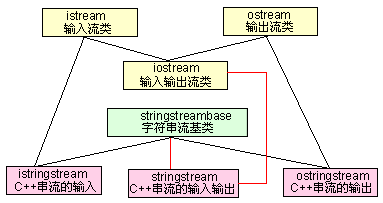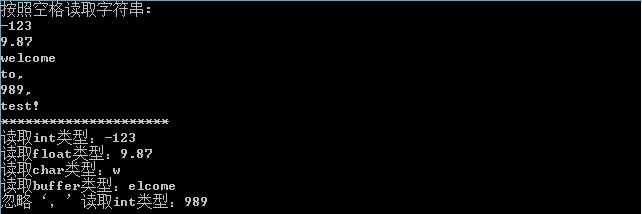C++中stringstream的使用方法和样例
之前在leetcode中进行string和int的转化时使用过istringstream,现在大致总结一下用法和测试用例。
介绍:C++引入了ostringstream、istringstream、stringstream这三个类,要使用他们创建对象就必须包含sstream.h头文件。
istringstream类用于执行C++风格的串流的输入操作。
ostringstream类用于执行C风格的串流的输出操作。
stringstream类同时可以支持C风格的串流的输入输出操作。
下图详细描述了几种类之间的继承关系:

istringstream是由一个string对象构造而来,从一个string对象读取字符。
ostringstream同样是有一个string对象构造而来,向一个string对象插入字符。
stringstream则是用于C++风格的字符串的输入输出的。
代码测试:
- #include<iostream>
- #include <sstream>
- using namespace std;<pre name="code" class="cpp">int main(){
- string test = "-123 9.87 welcome to, 989, test!";
- istringstream iss;//istringstream提供读 string 的功能
- iss.str(test);//将 string 类型的 test 复制给 iss,返回 void
- string s;
- cout << "按照空格读取字符串:" << endl;
- while (iss >> s){
- cout << s << endl;//按空格读取string
- }
- cout << "*********************" << endl;
-
- istringstream strm(test);
- //创建存储 test 的副本的 stringstream 对象
- int i;
- float f;
- char c;
- char buff[1024];
-
- strm >> i;
- cout <<"读取int类型:"<< i << endl;
- strm >> f;
- cout <<"读取float类型:"<<f << endl;
- strm >> c;
- cout <<"读取char类型:"<< c << endl;
- strm >> buff;
- cout <<"读取buffer类型:"<< buff << endl;
- strm.ignore(100, ',');
- int j;
- strm >> j;
- cout <<"忽略‘,’读取int类型:"<< j << endl;
-
- system("pause");
- return 0;
- }

总结:
1)在istringstream类中,构造字符串流时,空格会成为字符串参数的内部分界;
2)istringstream类可以用作string与各种类型的转换途径
3)ignore函数参数:需要读取字符串的最大长度,需要忽略的字符
代码测试:
- int main(){
- ostringstream out;
- out.put('t');//插入字符
- out.put('e');
- out << "st";
- string res = out.str();//提取字符串;
- cout << res << endl;
- system("pause");
- return 0;
- }
注:如果一开始初始化ostringstream,例如ostringstream out("test"),那么之后put或者<<时的字符串会覆盖原来的字符,超过的部分在原始基础上增加。
stringstream同理,三类都可以用来字符串和不同类型转换。
无欲则刚 关心则乱



